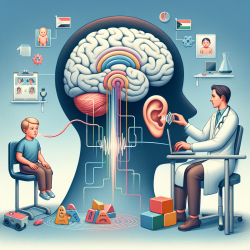Selective Mutism (SM) is a complex childhood disorder characterized by the consistent inability to speak in specific social situations despite the ability to speak normally in others. This condition can significantly impair social and academic functioning, leading to school failure, social difficulties, and strained family relationships. Recent research by Henkin and Bar-Haim (2015) offers an auditory-neuroscience perspective on SM, shedding light on potential neural mechanisms underlying this disorder. This blog aims to help practitioners improve their skills by implementing the outcomes of this research or encouraging further investigation.
Understanding the Auditory Efferent System
The auditory efferent system plays a crucial role in vocalization and auditory processing. Two key components are involved: the middle-ear acoustic reflex (MEAR) and the medial olivocochlear bundle (MOCB) reflex. These mechanisms help regulate and monitor vocalization, ensuring that self-produced sounds do not overwhelm the auditory system.
- MEAR: Controls the contraction of middle-ear muscles to attenuate sound during vocalization, preventing overloading of the cochlea.
- MOCB: Inhibits outer hair cell activity in the cochlea to improve signal-to-noise ratio, aiding in speech perception amidst background noise.
Findings from the Research
Henkin and Bar-Haim (2015) found that children with SM often exhibit aberrant auditory efferent function. Specifically, they observed that:
- 50% of children with SM displayed no MEAR at maximum stimulation level in multiple assessment conditions.
- Children with SM had significantly higher MEAR thresholds and a higher prevalence of abnormal MEAR decay functions.
- Reduced MOCB function was evident in a significant portion of children with SM.
These findings suggest that difficulties in simultaneously vocalizing and processing incoming sounds may contribute to the speech avoidance behavior observed in SM.
Implications for Treatment
The research indicates that current treatments for SM, which primarily focus on anxiety symptoms, may not effectively address the underlying auditory deficits. Future therapies could benefit from directly targeting these auditory deficiencies. Potential interventions include:
- Graded exposure to one's own voice via headphones.
- Simulation of speech in social situations with background noise.
- Computerized protocols to improve dual-task performance involving vocalization and auditory processing.
Additionally, neuroimaging and neurochemical research could reveal specific targets for pharmacological and non-invasive brain stimulation techniques, such as transcranial magnetic stimulation (TMS) or transcranial direct current stimulation (tDCS).
Encouraging Further Research
Given the preliminary nature of these findings, additional research is needed to further elucidate the interplay between aberrant auditory efferent function and the psychological and behavioral aspects of SM. Practitioners are encouraged to stay informed about ongoing research and consider incorporating neuroscience-based approaches into their practice.
To read the original research paper, please follow this link: An auditory-neuroscience perspective on the development of selective mutism.










